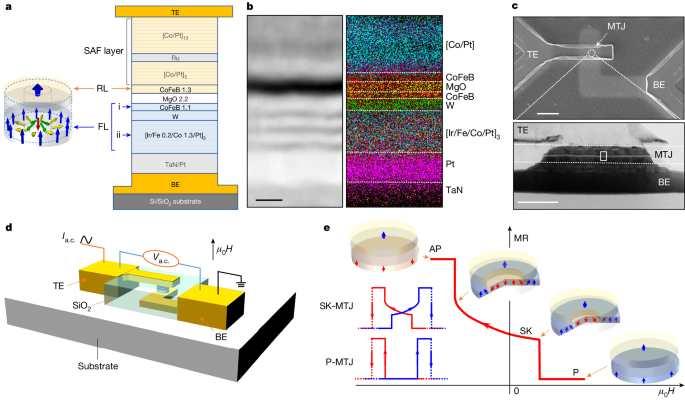Nanoscale Chiral Magnetic Tunnel Junction for Skyrmion Readout
Core Concepts
Nanoscale chiral magnetic tunnel junctions enable deterministic electrical readout of individual spin textures, offering promise for sustainable computing with low switching energies.
Abstract
The content introduces a breakthrough in the field of physics by presenting the wafer-scale realization of a nanoscale chiral magnetic tunnel junction (MTJ) capable of hosting a single ambient skyrmion. The key highlights are as follows:
Introduction to topological whirls or 'textures' of spins like magnetic skyrmions.
Promise of skyrmions as robust, nanometer-scale, mobile bits for sustainable computing.
Challenge of deterministic electrical readout of individual spin textures.
Presentation of MTJ nucleating fixed polarity skyrmions with large readout signals directly related to skyrmion size.
Exploitation of complementary nucleation mechanisms to stabilize distinctly sized skyrmions at zero field, realizing three non-volatile electrical states.
Ability to electrically write and delete skyrmions with significantly lower switching energies compared to existing technologies.
Application of applied voltage emulating a magnetic field reshaping energetics and kinetics for deterministic bidirectional switching.
Compatibility with lateral manipulation of skyrmionic bits for all-electrical device architectures.
This breakthrough opens up possibilities for multibit memory and unconventional computing using chiral spin textures.
All-electrical skyrmionic magnetic tunnel junction - Nature
Stats
The large readout signal is 20–70% relative to uniformly magnetized states.
Switching energies are 1,000 times lower than the state-of-the-art technology.
Quotes
"Here we present the wafer-scale realization of a nanoscale chiral magnetic tunnel junction (MTJ) hosting a single, ambient skyrmion."
"Our stack platform enables large readout and efficient switching, providing the much-anticipated backbone for all-electrical skyrmionic device architectures."
Key Insights Distilled From
by Shaohai Chen... at www.nature.com 03-20-2024
https://www.nature.com/articles/s41586-024-07131-7
Deeper Inquiries
How can this breakthrough in chiral spin textures impact the future development of computing technologies
The breakthrough in chiral spin textures, specifically the development of an all-electrical skyrmionic magnetic tunnel junction (MTJ), has significant implications for the future of computing technologies. By enabling deterministic electrical readout of individual spin textures like magnetic skyrmions, this advancement paves the way for sustainable computing with nanometre-scale, mobile bits. These chiral spin entities offer high stability and promise as robust components for next-generation memory and processing devices. The ability to nucleate and manipulate skyrmions electrically opens up possibilities for efficient data storage and processing at a scale previously unattainable. With large readout signals corresponding directly to skyrmion size, this technology provides a foundation for multibit memory architectures that can revolutionize computing efficiency.
What potential drawbacks or limitations might arise from relying solely on all-electrical skyrmionic device architectures
While all-electrical skyrmionic device architectures offer exciting prospects for computing technologies, there are potential drawbacks and limitations to consider. One concern is the complexity involved in fabricating these intricate structures on a wafer scale, which may pose challenges in terms of scalability and cost-effectiveness. Additionally, relying solely on chiral spin textures for data storage and processing could introduce issues related to reliability and durability over extended usage periods. Furthermore, ensuring compatibility with existing hardware systems and integration into mainstream computing platforms may require substantial effort and resources. Addressing these drawbacks will be crucial in realizing the full potential of all-electrical skyrmionic device architectures.
How can the concept of deterministic bidirectional switching be applied in other fields beyond physics and computing
The concept of deterministic bidirectional switching demonstrated in the context of chiral spin textures can find applications beyond physics and computing in various fields such as robotics, telecommunications, and biotechnology. In robotics, deterministic bidirectional switching mechanisms inspired by chiral spin dynamics could enhance control systems' efficiency by enabling precise manipulation or movement sequences with low energy consumption. Telecommunications could benefit from faster signal routing or data transmission protocols based on bidirectional switching principles derived from this research area. Moreover, applying deterministic bidirectional switching concepts to biotechnology could lead to advancements in drug delivery systems or molecular manipulation techniques that require precise control over directional changes at a microscopic level.
0
